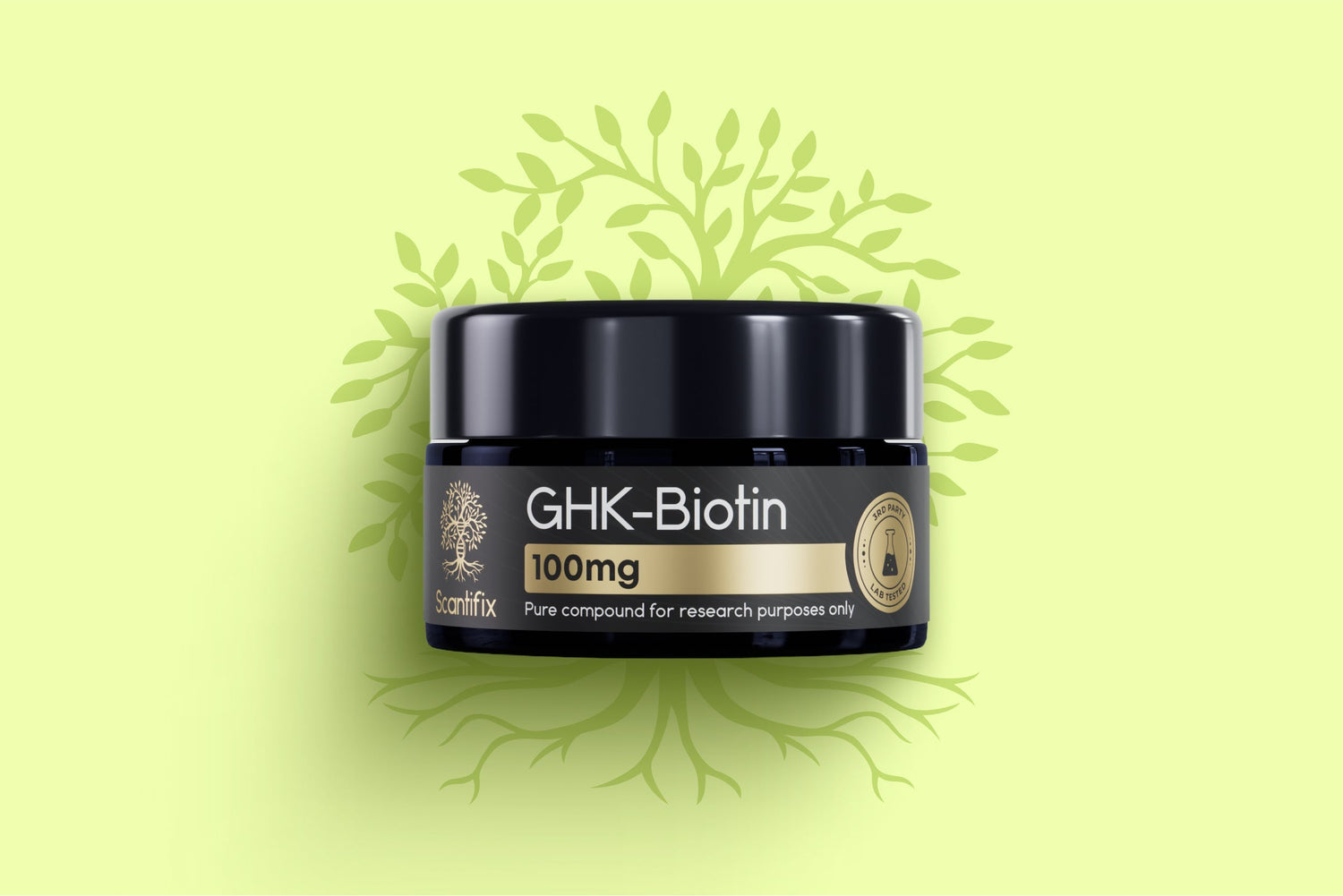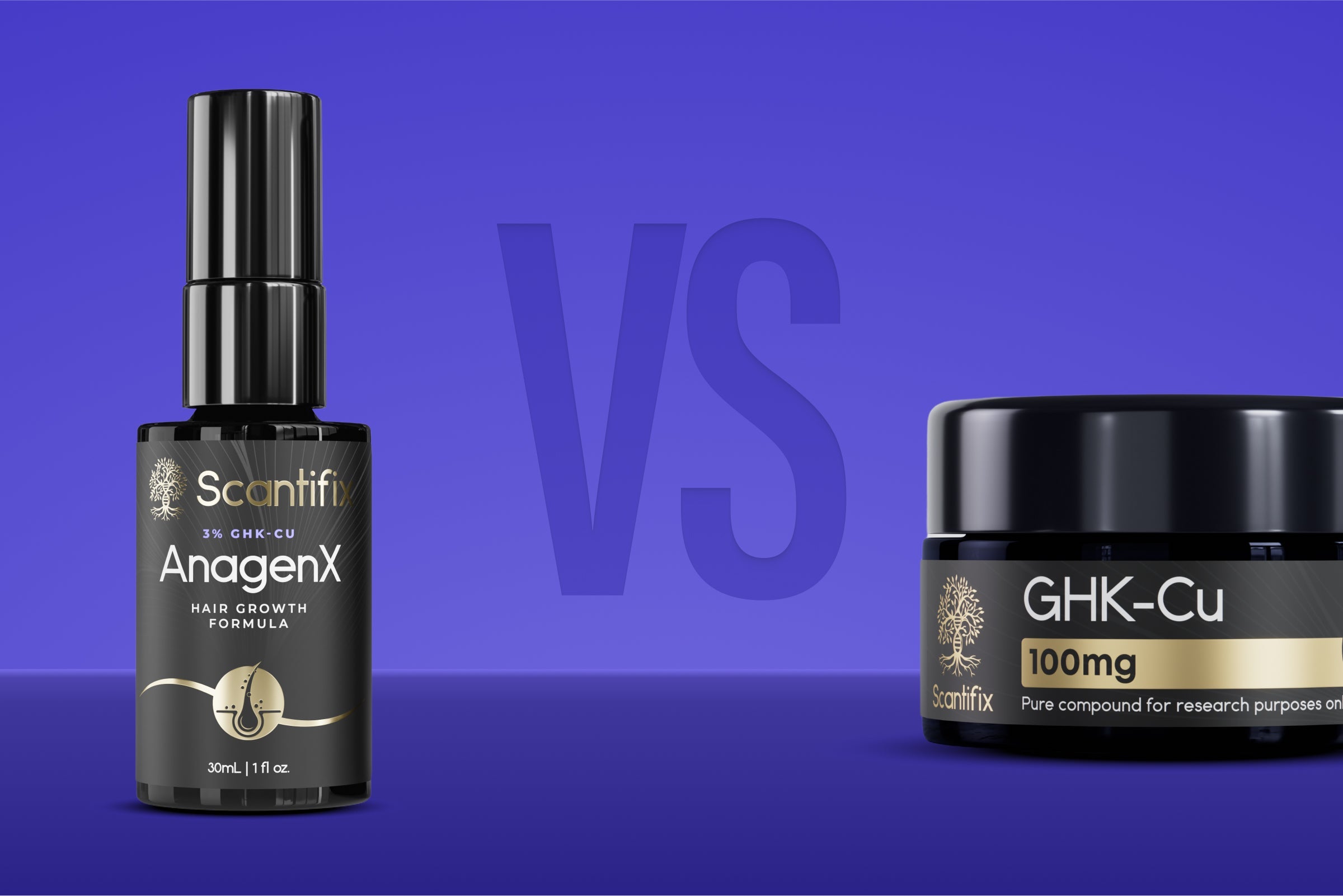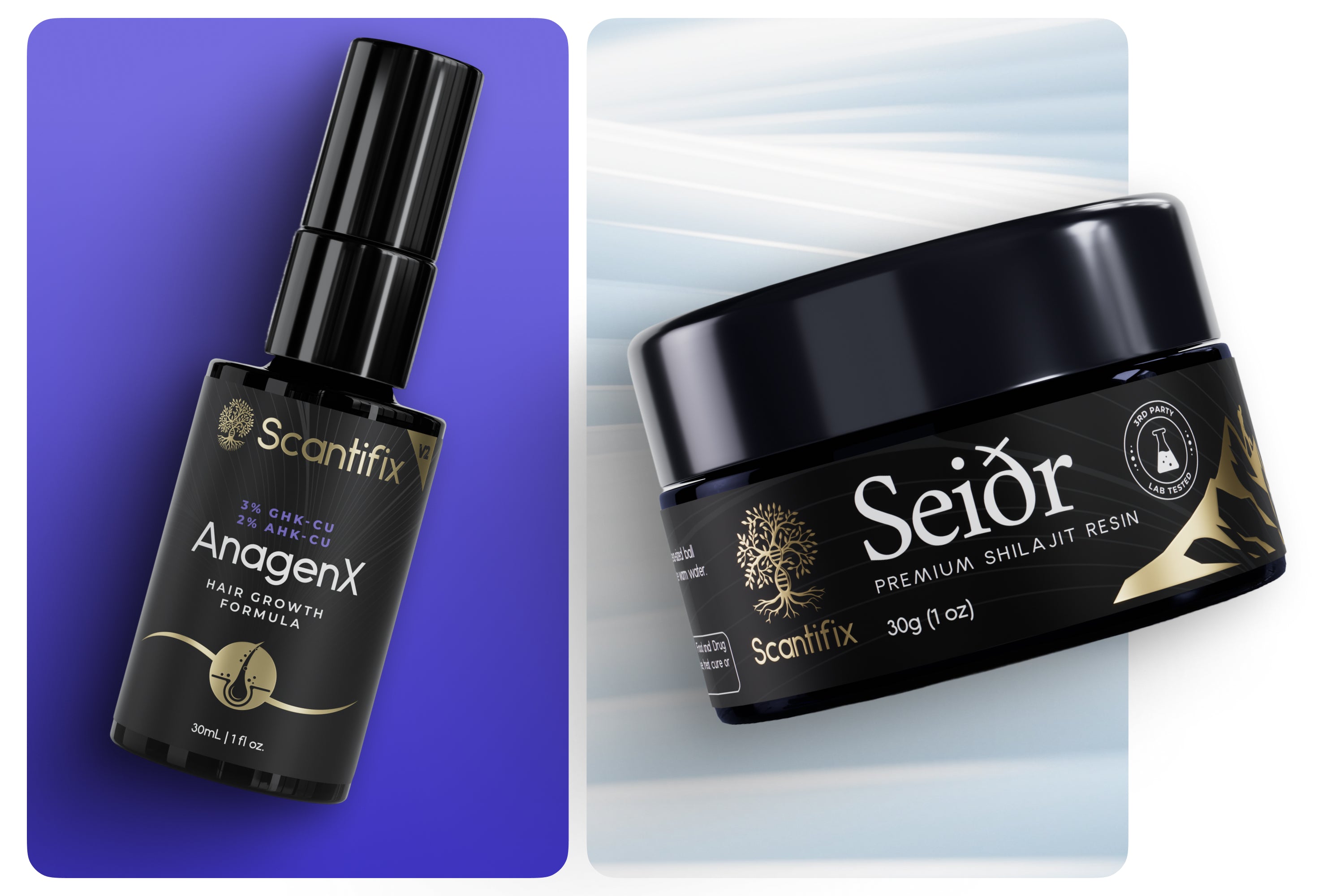GHK-Biotin is an emerging hybrid peptide that brings together two well-studied, biologically active ingredients: the regenerative tripeptide GHK and the B-vitamin biotin. Together, they form a molecule that has potential to support hair strength, scalp health, and possibly skin repair without harsh drugs or irritating ingredients.
Early findings suggest GHK-Biotin may help anchor hair in the growth phase and stimulate activity in both follicles and surrounding skin tissue. Although relatively new, It appears that GHK-Biotin could have a lot to offer in biologically guided hair and skin care and is worth exploring further.
Let’s take a closer look at what GHK-Biotin is, how it may work, what the research suggests about its benefits for hair and skin, and the best way to incorporate it into your routine.
What Is GHK-Biotin?
GHK-Biotin (also known as Biotinoyl Tripeptide-1) is a compound that chemically links two well-known molecules:
-
- GHK (Glycyl-Histidyl-Lysine): A naturally occurring tripeptide known for its roles in wound healing, tissue remodeling, and collagen production. It has been studied for decades in the context of both skin regeneration and hair follicle stimulation.
- Biotin (Vitamin B7): A B-complex vitamin that plays a key role in supporting keratin infrastructure in hair, skin, and nails. It’s commonly used in oral supplements and topical serums targeting brittle or thinning hair.
By combining these two components, GHK-Biotin aims to deliver biotin more directly to the scalp or skin while leveraging GHK’s regenerative signaling properties to enhance absorption and activity at the cellular level.
How Does GHK-Biotin Work?
While GHK and biotin are individually recognized for their benefits, the hybrid form might offer a more targeted and synergistic effect. Early insights suggest these potential actions:
-
- Stimulating Follicular Activity: GHK is known to encourage cellular signaling pathways related to tissue repair and regeneration. When delivered to the scalp, this may help energize dormant or slow follicles.
- Enhancing Keratin Production: Biotin supports the structural proteins that make up the hair shaft. When bound to GHK, it may reach deeper layers of the follicle and scalp.
- Anchoring Hair at the Root: GHK-Biotin has been proposed to reinforce the extracellular matrix around hair follicles, helping to reduce shedding and support stronger anchoring.
- Promoting Cell Proliferation: In vitro models show that it may upregulate markers like Ki-67, which is associated with active cell division in hair matrix cells.
These effects work together to support a more favorable environment for hair retention and regrowth, particularly when used topically over several months.
GHK-Biotin Benefits
For Hair Health
One study looked at the effects of a GHK-Biotin topical solution in men with alopecia. Participants applied a 10 ppm lotion twice daily for four months. Key findings included:
-
- A significant increase in the anagen/telogen ratio, meaning more hairs were in the active growth phase compared to those at rest or shedding. This could translate to visibly fuller hair and reduced thinning over time.
- In cultured hair follicles, GHK-Biotin at 2 ppm stimulated Ki‑67 expression, a marker of cell proliferation, which indicates that more hair-producing cells were actively dividing. This is a key process for initiating and sustaining hair growth and may help promote stronger regrowth over time (Active Peptide Company, 2014).
These effects were comparable to minoxidil—a common hair loss drug used to stimulate growth—at the same concentration. However, unlike minoxidil, which can come with side effects like scalp irritation or unwanted hair growth in unintended areas (Suchonwanit et al., 2019), GHK-Biotin is being studied as a gentler alternative with potentially fewer risks.
These findings suggest that GHK-Biotin could support follicular activation and hair density without relying on harsh treatments. It’s one reason why interest in peptides for hair growth continues to grow.
For Skin Health
While fewer studies have focused on skin-specific benefits of GHK-Biotin, early data shows that its components individually support:
-
- Collagen production (GHK)
- Improved skin barrier function and hydration
- Structural integrity of skin and nails (Biotin)
In terms of everyday benefits, this could mean skin that retains moisture more effectively, feels stronger and more resilient, and shows fewer signs of dryness or fragility. While more research is needed to confirm these effects specifically for GHK-Biotin, what we do know about the individual compounds points to a peptide with potential relevance in broader skin health routines.
One of the most promising aspects of GHK-Biotin is the extensive research behind the GHK portion of the molecule. One of the most well-known and widely used peptides for both skin and hair is GHK-Cu, the copper-bound version of GHK. Let's take a closer look at how GHK-Biotin compares to GHK-Cu and where each might be best suited in a topical routine.
GHK-Biotin vs. GHK-Cu
Both GHK-Biotin and GHK-Cu are based on the same core peptide, GHK, but they diverge in what they’re bound to, and in their primary applications.
 GHK-Cu is one of the most studied peptides in dermatological research. It’s widely known for its ability to:
GHK-Cu is one of the most studied peptides in dermatological research. It’s widely known for its ability to:
-
- Stimulate collagen and elastin production
- Reduce inflammatory markers like IL-6 and TNF-alpha
- Reactivate dormant hair follicles
- Support wound healing and skin recovery (Pickart & Margolina, 2018)
If you’re exploring peptides for hair growth or skin care, GHK-Cu peptide benefits remain widely renowned. That said, GHK-Biotin may offer a more direct benefit for strand anchoring and follicle structure, making it a smart complementary option when paired with GHK-Cu. Used together, they may support both the structural integrity of the hair and the regenerative activity of the follicle, offering a more comprehensive and layered approach.
How GHK-Biotin Is Used in Hair and Skin Products
1. Raw Peptide Format
GHK-Biotin is available in lyophilized (freeze-dried) powder form, giving users and formulators full control. When reconstituted with sterile water or peptide-safe carriers, it can be used to create custom skincare formulas such as:
-
- Biotin hair serums
- Scalp solutions
- Skin or eye creams
The advantage of using raw peptides is flexibility. You can combine them with hyaluronic acid, niacinamide, or other actives depending on your specific goals.
2. Professional Serums and Creams
You’ll also find GHK-Biotin in ready-made skincare products, particularly those targeting hair regrowth, lash or brow support, or "3-in-1" formulations for hair, skin, and nails. Quality can vary significantly between brands, so it’s important to choose products with transparent sourcing and clinical concentrations.
Let's review what to look for when choosing a GHK-Biotin product.
What to Look for in the Best GHK-Biotin Products
Not all peptide products are created equally. When selecting a GHK-Biotin serum or raw ingredient, consider the following:
-
- Purity: Should be 98%+ and third-party verified.
- Formulation: Look for clean ingredient lists with no unnecessary fillers, fragrances, or alcohols.
- Transparency: Trustworthy brands provide full COAs (Certificates of Analysis) and sourcing details.
- Packaging: Peptides are sensitive to light and temperature. Amber or violet glass packaging helps preserve activity.
- Stability: Raw peptides should be stored in a cool, dark environment, preferably refrigerated after opening.
Unfortunately, not every hair and skin care brand adheres to these kinds of standards. Most rely on buzzwords, filler ingredients, and peptides in barely-there amounts—often with impurities they never disclose. If you don't want to second guess what you put on your skin or scalp, visit our shop for transparent, high quality peptide products.
AnagenX: A Synergistic Multi-Peptide Serum Featuring GHK-Biotin
AnagenX harnesses all of the potential of GHK-Biotin and complements it with GHK-Cu and BPC-157. The result is a clean, science-led formula to support stronger, fuller, healthier hair.
This trio works synergistically to support:
-
- Follicle stimulation and growth phase reactivation (GHK-Cu)
- Scalp environment recovery and circulation (BPC-157)
- Strand strengthening and anchoring (GHK-Biotin)
Together, they target hair health from every angle for comprehensive support without harsh chemicals or risky side effects associated with other hair growth treatments.
Each bottle is third-party tested, filler-free, vegan, and packaged in MIRON Violetglass to preserve potency over time. If you're looking to explore the benefits of GHK-Biotin, it checks all the boxes for a trustworthy, effective peptide product.
Final Thoughts: Is GHK-Biotin Right for Your Routine?
GHK-Biotin is still a relatively new peptide, but what we know so far suggests it may offer a meaningful, biologically intelligent way to support hair strength, scalp vitality, and possibly skin resilience—especially when used in combination with other regenerative peptides.
If you're interested in customizing your own hair or skin formulations, raw GHK-Biotin offers flexibility and high purity. If you're looking for a more complete solution, AnagenX brings together GHK-Biotin, GHK-Cu, and BPC-157 into a streamlined formula backed by science and transparency.
References
Active Peptide Company. (2014). Biotin-GHK in hair follicle and hair loss: Scientific presentation. https://www.activepeptide.com/wp-content/uploads/2014/06/Biotin-GHK-Presentation-Active-Peptide-Company.pdf
Pickart, L., & Margolina, A. (2018). Regenerative and protective actions of the GHK-Cu peptide in the light of the new gene data. International Journal of Molecular Sciences, 19(7), 1987. https://doi.org/10.3390/ijms19071987
Suchonwanit, P., Thammarucha, S., & Leerunyakul, K. (2019). Minoxidil and its use in hair disorders: a review. Drug design, development and therapy, 13, 2777–2786. https://doi.org/10.2147/DDDT.S214907






Leave a comment
All comments are moderated before being published.
This site is protected by hCaptcha and the hCaptcha Privacy Policy and Terms of Service apply.